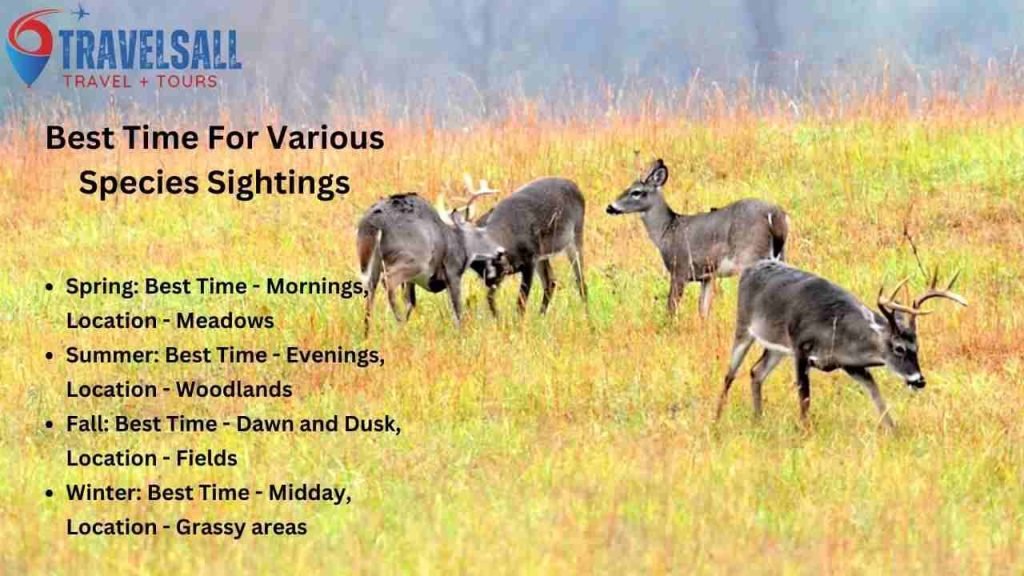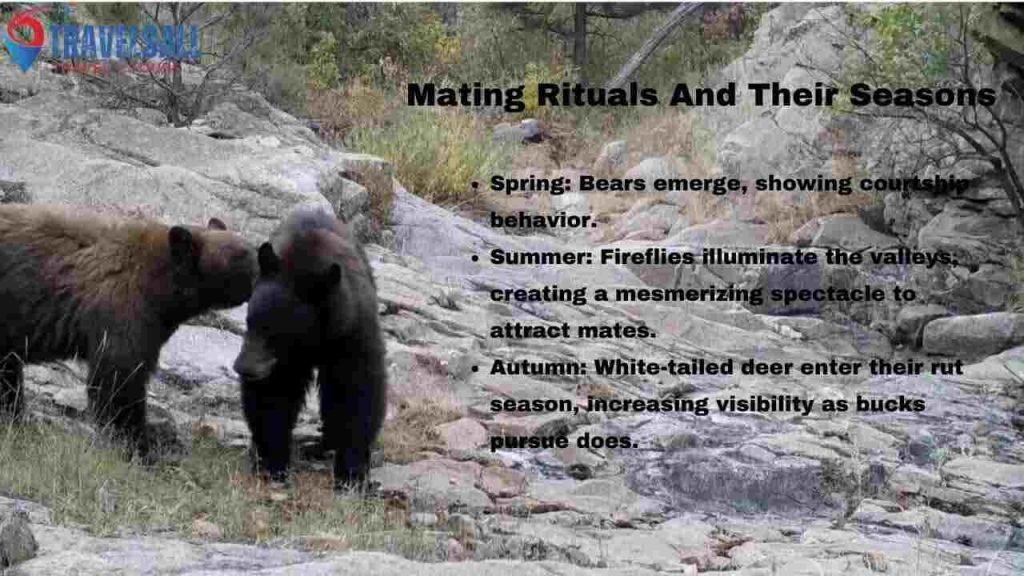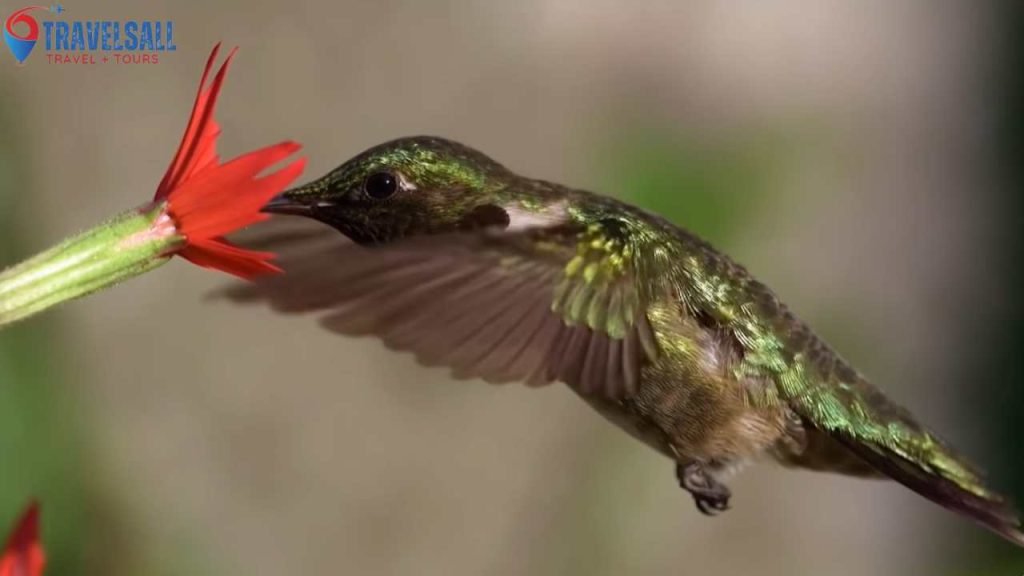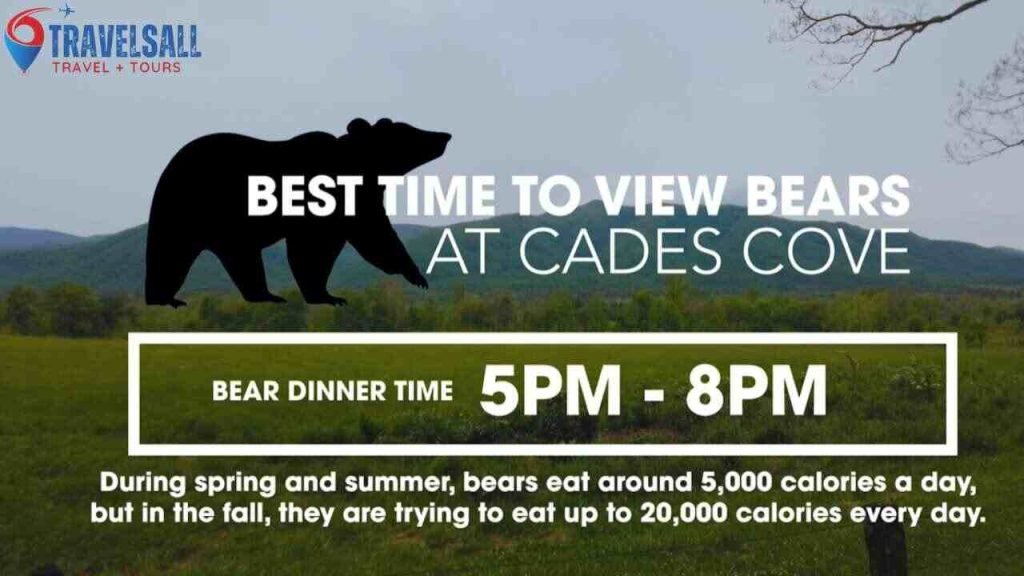The best time to see wildlife in Cades Cove is either early in the morning or late in the afternoon. These periods offer increased animal activity and fewer crowds.
Cades Cove, Settled in the Great Smoky Mountains National Park, stands as a prime destination for wildlife viewing.
This verdant valley, surrounded by mountains, is home to a rich variety of animals. It includes white-tailed deer, black bears, coyotes, and turkeys.
Dawn and dusk are ideal for spotting these creatures as they are most active during these times.
Visitors seeking to maximize their wildlife encounters should aim for these hours. Especially during the quieter seasons of spring and fall.
The reduced human presence during these times not only increases the chances of sighting but also enhances the serenity of the experience. It allows for unobstructed views of animals in their natural habitat.
Table of Contents
ToggleCades Cove’s Majestic Wildlife

Cades Cove offers a window into the world of wildlife in the Great Smoky Mountains. Be it the rustling leaves as deer pass by or the evening hoot of a distant owl, nature sings.
This scenic valley is a haven for enthusiasts and photographers alike.
Diverse Habitats And Species
Diversity is the hallmark of Cades Cove’s ecosystem. From dense forests to open meadows,
all life thrives here. The cove houses an array of species waiting to dazzle visitors through the seasons.
- Spring: Wildflowers bloom, bears emerge.
- Summer: Elk feed at dusk, songbirds serenade.
- Fall: Plentiful antlered bucks, colorful migratory birds.
- Winter: Quiet landscapes, hardy winter species.
Conservation Efforts Shaping Wildlife Viewings
Protection efforts in Cades Cove ensure a future for wildlife. Endangered species find refuge,
while visitors get a glimpse into nature’s resolve. Preservation champions the very heart of these animal encounters.
| Effort | Impact on Wildlife |
|---|---|
| Habitat Restoration | Boosts species diversity |
| Anti-Poaching Measures | Ensures safe breeding |
| Educational Programs | Engages the public, promotes stewardship |
Seasonal Patterns Of Animal Activity
Wildlife in Cades Cove follows the ebb and flow of the seasons. Each phase of the year brings unique opportunities to witness nature’s marvels. Let’s explore when these forest inhabitants are most active and visible.
Spring Bloom: New Life Emerges
As the grip of winter loosens, springs breathe new life into Cades Cove. Trees bud, flowers bloom, and animals reemerge. This season, typically starting in March and ending in May, offers a special treat for visitors.
- Baby animals make their first steps.
- Bears come out of hibernation.
- Birds return from their winter migrations.
Summer Abundance: Peak Visits
Summer, from June to August, attracts the most visitors to Cades Cove. The valley is alive with activity, and wildlife is no exception.
| Animal | Activity |
|---|---|
| Deer | Grazing in open fields |
| Elk | Bugling calls fill the air |
| Wild Turkeys | Strutting with tail fans displayed |
Autumn Transitions: The Preparing Wildlife
Autumn in Cades Cove, from September to November, is a time of preparation. Animals ready themselves for the cold months ahead.
- Bears increase their food intake.
- Squirrels gather and store nuts.
- Migratory birds start their journey south.
Winter Wonders: The Brisk Silence
December to February brings a tranquil hush over Cades Cove. Wildlife sightings are rarer, but those who brave the chill might catch an unforgettable glimpse.
- Deer forage in snowy meadows.
- Hardy birds flit among bare branches.
- Owls may hoot in the crisp air.
Best Time For Various Species Sightings

Welcome to the best times for various species sightings in the enchanting Cades Cove.
Settled within the Great Smoky Mountains National Park, this valley boasts a rich tapestry of wildlife. Read on to discover the peak times to observe the incredible fauna that calls this place home.
Prime Time For Black Bears
Late spring through early fall marks the best time for black bear sightings. During May and June, bear activity peaks as they forage for food after the long winter.
Early mornings and late afternoons offer the highest chance of spotting these majestic creatures. Remember to keep a safe distance for a thrilling yet responsible experience.
Deer Spotting Opportunities Throughout The Year
Deer, graceful residents of Cades Cove, grace visitors with their presence all year. However, autumn brings out the largest numbers, particularly at dawn and dusk.
Fields and meadows near the loop road are hotspots for deer enthusiasts.
| Season | Best Time | Location |
|---|---|---|
| Spring | Mornings | Meadows |
| Summer | Evenings | Woodlands |
| Fall | Dawn and Dusk | Fields |
| Winter | Midday | Grassy areas |
Bird Watching Extravaganza
Cades Cove offers a paradise for bird watchers. Spring migration brings a flurry of colorful feathered friends.
Look out for warblers, vireos, and flycatchers. The sheltered valley also provides year-round habitats for resident birds like wild turkeys and pileated woodpeckers.
Don’t forget your binoculars for the best viewing opportunities.
- Spring: Migration Season
- Summer: Breeding Plumage Display
- Fall: Second Migration Wave
- Winter: Easy Spotting Against Snow
Behavioral Cycles Influencing Sightings
Exploring the splendor of Cades Cove offers a window into the vibrant lives of its wild inhabitants. Seasonal cycles enhance chances to observe creatures’ behaviors, rituals, and migrations.
Mating Rituals And Their Seasons

During specific times of the year, Cades Cove transforms into a stage for nature’s intricate mating performances.
Bold displays of colors, sounds, and behaviors reveal themselves as animals engage in their courting traditions.
- Spring: Bears emerge, showing courtship behavior.
- Summer: Fireflies illuminate the valleys, creating a mesmerizing spectacle to attract mates.
- Autumn: White-tailed deer enter their rut season, increasing visibility as bucks pursue does.
Migration And The Right Timing To Observe
Migratory patterns offer unique opportunities for wildlife observation. Timing is everything to catch sight of these incredible journeys.
| Season | Wildlife | Optimal Viewing Period |
|---|---|---|
| Spring | Birds | Early mornings for songbirds returning north |
| Fall | Monarch Butterflies | Late afternoons as they migrate south |
Align visits with these periods for a chance to observe wildlife in motion, enriching the overall experience in Cades Cove.
Daily Rhythms: Dawn Or Dusk
Wildlife emerges in sync with the sun’s journey along the Cades Cove loop, creating a unique spectacle.
Dawn and dusk, with their distinctive light and quieter park activity, provide prime wildlife spotting opportunities.
Early Morning Excitement
As the first light cuts through the misty mountain air, early risers are greeted by an orchestra of birdsong.
Deer roam the meadows, often shrouded in a gentle fog. A quiet stroll or drive at this time increases the chances of witnessing these peaceful moments.
- Deer grazing in the open fields
- A chance to hear wild turkeys call
- Birds of all kinds starting their day
The Golden Hour: Dusk’s Enchanting Wildlife Display
The waning hours of daylight, known as the ‘golden hour’, cast a warm glow that seems to breathe life into the valley. Wildlife, particularly nocturnal creatures, begin their nightly routines.
| Animal | Activity |
|---|---|
| Black Bears | Foraging before nightfall |
| Owls | Starting their hunt |
| Foxes | Emerging from their dens |
Photographers and nature lovers alike treasure this time for the soft lighting and active wildlife scenes.
Impact Of Weather On Wildlife Viewing

The impact of weather on wildlife viewing is dramatic. Cades Cove offers amazing encounters with wildlife, but the time of year and weather conditions can significantly determine what you see.
Learning the interplay between weather patterns and animal behavior enhances your viewing experience.
Bearing The Brunt: Bad Weather Days
Wild animals have adapted to various weather conditions. Rain, snow, and wind change their behavior.
During heavy downpours or snowfall, many animals seek shelter. These conditions might reduce sightings.
Nonetheless, post-storm periods can be rewarding. Animals often emerge to feed and are more visible against the fresh backdrop.
- Rainy Days: Look for deer and other mammals in sheltered areas.
- Snowfall: Track prints lead to active wildlife spots.
- Wind: Birds may be grounded, but ground animals become active.
When Sunshine Brings Out The Wilderness
Sunny, clear days can be perfect for wildlife viewing. Warmth brings many animals out to bask and forage. Early mornings and late afternoons are peak times. The light is less harsh and animals are active.
| Wildlife Activity During Sunny Weather | ||
|---|---|---|
| Mornings | Afternoons | Species Observed |
| Birds singing | Elk grazing | Birds, Elk, Bears |
| Frolicking foxes | Bears foraging | Foxes, Bears |
Tips for Sunny Days:
- Bring binoculars for distant animal spotting.
- Stay quiet; noise reduces sightings.
- Wear neutral colors; bright colors scare animals.
Guided Tours Vs. Solo Adventures
Wildlife enthusiasts often debate the best way to experience Cades Cove: guided tours or solo adventures.
Let’s dig into the pros and cons of both, so you can decide which suits your nature-loving spirit.
Choosing A Guided Tour For Expert Insight
Guided tours in Cades Cove offer unparalleled access to expert knowledge. As we explore this option, consider the following advantages:
- Learn from Experienced Guides: They share fascinating facts and stories about local wildlife.
- Spot Hidden Creatures: Guides know where animals love to roam and rest.
- Stay Safe: Experts can keep you at a safe distance from wild animals.
These experiences provide a structured itinerary. It covers key spots known for animal sightings.
Tables are excellent for displaying tour options:
| Type of Tour | Duration | Wildlife Focus |
|---|---|---|
| Sunrise Safari | 2 hours | Early birds and deer |
| Nocturnal Adventure | 3 hours | Owls and foxes |
Starting On A Personal Wildlife Quest
Solo adventures in Cades Cove cater to those who prefer a more personal experience. Here’s what you gain:
- Flexibility: Move at your own pace and follow your curiosity.
- Serenity: Enjoy the peace of the wilderness without a group.
- Freedom: Choose where to go and what to focus on.
Prepare well before you set out:
- Bring binoculars for distant animals.
- Carry a map to navigate the Cove.
- Pack plenty of water and snacks.
Remember, respect nature by observing without interfering.
Frequently Asked Questions Of When Is The Best Time To See Wildlife In Cades Cove
What Is The Best Time To See Animals At Cades Cove?
The best time to see animals at Cades Cove is either early in the morning or late afternoon before sunset.
What Time Are Bears Out Cades Cove?
Bears in Cades Cove are most active during early mornings and late afternoons, especially during spring and summer.
Where Can I See Animals In Cades Cove?
You can spot wildlife in Cades Cove by traversing the Loop Road, exploring the trails, or visiting the meadows at dawn or dusk.
When Can You See Elk In Cades Cove?
You can see elk in Cades Cove at dawn and dusk, which are their most active times, primarily during spring, summer, and fall.
Conclusion
Embarking on a wildlife adventure in Cades Cove promises an array of seasonal spectacles. Early mornings during spring and fall offer prime viewing opportunities, as do summer’s twilight hours. Remember, respectful observation ensures a sustainable future for this natural haven and its inhabitants.
Secure your spot in the great outdoors and treasure the moments of wild wonder in Cades Cove.



